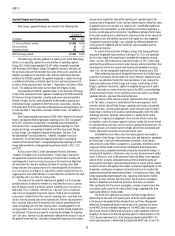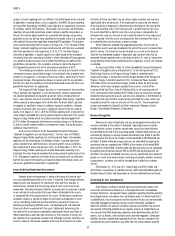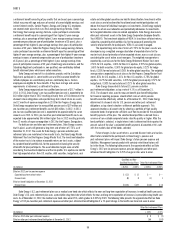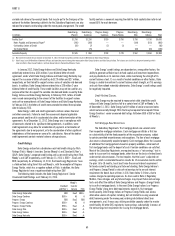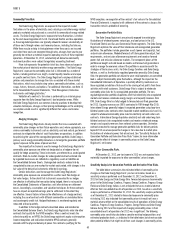Duke Energy 2012 Annual Report Download - page 81
Download and view the complete annual report
Please find page 81 of the 2012 Duke Energy annual report below. You can navigate through the pages in the report by either clicking on the pages listed below, or by using the keyword search tool below to find specific information within the annual report.
61
PART II
Other Financing Matters.
The following table shows signifi cant amounts presented as Current
maturities of long-term debt on the Duke Energy Registrants respective
Consolidated Balance Sheets as of December 31, 2012. The amounts were
presented as Long-term debt as of December 31, 2011, except for the secured
debt. The Duke Energy Registrants’ currently anticipates satisfying these
obligations with proceeds from additional borrowings, unless otherwise noted.
(in millions) Maturity Date Interest Rate December 31, 2012
Unsecured Debt:
Duke Energy (Parent) June 2013 5.650 % $ 250
Duke Energy Indiana September 2013 5.000 % 400
Secured Debt:
Duke Energy(a) December 2013 3.796 % 423
Duke Energy(b) June 2013 1.009 % 190
First Mortgage Bonds:
Duke Energy Carolinas November 2013 5.750 % 400
Progress Energy Carolinas September 2013 5.125 % 400
Progress Energy Florida March 2013 4.800 % 425
Duke Energy Ohio June 2013 2.100 % 250
Other 372
Current maturities of
long-term debt $3,110
(a) Represents a construction loan related to a renewable energy project that will be converted to a term loan
once construction is complete.
(b) Notes are fully offset with cash collateral, which is recorded in Other current assets in the Consolidated
Balance Sheets as of December 31, 2012.
On November 13, 2012, Duke Energy fi led a prospectus supplement to
the September 2010 Form S-3 with the Securities and Exchange Commission
(SEC), to sell up to $1 billion of fi xed or variable rate unsecured senior notes,
called InterNotes, due one year to 30 years from the date of issuance. The
InterNotes will be issued in the retail markets as direct, unsecured and
unsubordinated obligations of Duke Energy Corporation. The net proceeds from
the sale of InterNotes will be used to fund capital expenditures in Duke Energy’s
unregulated businesses and for general corporate purposes. The balance as of
December 31, 2012 is $35 million, with maturities ranging from 10 to14 years.
The notes refl ect long-term debt obligations of Duke Energy and are refl ected as
Long-term debt on Duke Energy’s Consolidated Balance Sheets.
On March 1, 2012, Progress Energy, as a well-known seasoned issuer,
Progress Energy Carolinas and Progress Energy Florida fi led a combined shelf
registration statement with the SEC, which became effective upon fi ling with
the SEC. The registration statement is effective for three years and does not
limit the amount or number of various securities that can be issued. On July 3,
2012, Progress Energy deregistered its equity securities from the registration
statement in connection with the merger with Progress Energy, but retained
its ability to issue senior debt securities and junior subordinated debentures
under the registration statement. However, we do not expect Progress Energy
to issue any new securities of these types in the future. Under Progress Energy
Carolinas’ and Progress Energy Florida’s registration statements, they may issue
various long-term debt securities and preferred stock.
On April 4, 2011, Duke Energy fi led a registration statement (Form S-3)
with the SEC to sell up to $1 billion (maximum of $500 million of notes
outstanding at any particular time) of variable denomination fl oating rate
demand notes, called PremierNotes. The notes are offered on a continuous basis
and bear interest at a fl oating rate per annum determined by the Duke Energy
PremierNotes Committee, or its designee, on a weekly basis. The interest rate
payable on notes held by an investor may vary based on the principal amount of
the investment. The notes have no stated maturity date, but may be redeemed
in whole or in part by Duke Energy at any time. The notes are non-transferable
and may be redeemed in whole or in part at the investor’s option. Proceeds from
the sale of the notes will be used for general corporate purposes. The balance as
of December 31, 2012 and December 31, 2011, is $395 million and $79 million,
respectively. The notes refl ect a short-term debt obligation of Duke Energy
and are refl ected as Notes Payable and Commercial Paper on Duke Energy’s
Consolidated Balance Sheets.
In September 2010, Duke Energy fi led a Form S-3 with the SEC. Under
this Form S-3, which is uncapped, Duke Energy, Duke Energy Carolinas, Duke
Energy Ohio and Duke Energy Indiana may issue debt and other securities in the
future at amounts, prices and with terms to be determined at the time of future
offerings. The registration statement also allows for the issuance of common
stock by Duke Energy.
Duke Energy has paid quarterly cash dividends for 87 consecutive years
and expects to continue its policy of paying regular cash dividends in the future.
There is no assurance as to the amount of future dividends because they
depend on future earnings, capital requirements, fi nancial condition and are
subject to the discretion of the Board of Directors.
Dividend and Other Funding Restrictions of Duke Energy Subsidiaries.
As discussed in Note 4 to the Consolidated Financial Statements
“Regulatory Matters,” Duke Energy’s wholly owned public utility operating
companies have restrictions on the amount of funds that can be transferred to
Duke Energy via dividend, advance or loan as a result of conditions imposed
by various regulators in conjunction with Duke Energy’s mergers with Cinergy
and Progress Energy. Progress Energy Carolinas and Progress Energy Florida
also have restrictions imposed by their fi rst mortgage bond indentures and
Articles of Incorporation which, in certain circumstances, limited their ability
to make cash dividends or distributions on common stock. Additionally, certain
other Duke Energy subsidiaries have other restrictions, such as minimum
working capital and tangible net worth requirements pursuant to debt and other
agreements that limit the amount of funds that can be transferred to Duke
Energy. At December 31, 2012, the amount of restricted net assets of wholly
owned subsidiaries of Duke Energy that may not be distributed to Duke Energy
in the form of a loan or dividend is $10.3 billion. However, Duke Energy does
not have any legal or other restrictions on paying common stock dividends to
shareholders out of its consolidated equity accounts. Although these restrictions
cap the amount of funding the various operating subsidiaries can provide to
Duke Energy, management does not believe these restrictions will have any
signifi cant impact on Duke Energy’s ability to access cash to meet its payment
of dividends on common stock and other future funding obligations.
Off-Balance Sheet Arrangements
Duke Energy and certain of its subsidiaries enter into guarantee
arrangements in the normal course of business to facilitate commercial
transactions with third parties. These arrangements include performance
guarantees, stand-by letters of credit, debt guarantees, surety bonds and
indemnifi cations.
Most of the guarantee arrangements entered into by Duke Energy enhance
the credit standing of certain subsidiaries, non-consolidated entities or less
than wholly owned entities, enabling them to conduct business. As such, these
guarantee arrangements involve elements of performance and credit risk, which
are not included on the Consolidated Balance Sheets. The possibility of Duke
Energy, either on its own or on behalf of Spectra Energy Capital, LLC (Spectra
Capital) through indemnifi cation agreements entered into as part of the spin-off
of Spectra Energy Corp (Spectra Energy), having to honor its contingencies is
largely dependent upon the future operations of the subsidiaries, investees and
other third parties, or the occurrence of certain future events.
Duke Energy performs ongoing assessments of their respective guarantee
obligations to determine whether any liabilities have been incurred as a result of
potential increased non-performance risk by third parties for which Duke Energy
has issued guarantees.



